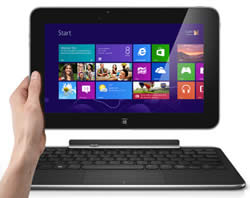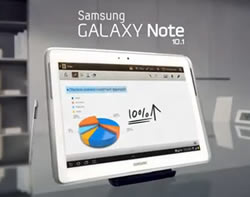Difference between Dell XPS 10 and Galaxy Note 10.1
Key Difference: The Dell XPS 10 is a 10.1-inch tablet that comes with a keyboard Dock to make it into a laptop. The screen is an HD Display capacitive multi-touch screen, with 1366 x 768 pixels and an approximately 155 ppi pixel density. The sleek tablet has a metal chassis and has a rubber back for better gripping. The Galaxy Note 10.1 is a tablet computer designed and manufactured by Samsung. It features a 10.1-inch screen and is marketed as a platform for multimedia consumption including movies, music, and web browsing. The Note 10.1 also features the use of a stylus named the S-Pen. The Note 10.1 runs on Android 4.0.
Dell is a popular company that is well-known for its customizable computers. It allowed people to build laptops and desktops from scratch, adding only components they need and paying only for those components. It has become a popular name in laptops, but has yet to launch itself in the tablet market. In response to the growing market for tablets the company has launched Dell Streak, which did not manage to garner much positive response for the company. Dell announced in August that is launching its newest table the Dell XPS 10 in October 2012.
 The Dell XPS 10 is a 10.1-inch tablet that comes with a keyboard Dock to make it into a laptop. The tablet serves the purpose of fulfilling the need for the tablet on the go and a laptop for some serious professional work. The company has launched the tablet on the Windows RT OS, which have not been able to draw in many customers. According to every review website, the company has not been doing that well in sales of tablets due to the Windows OS. However, the design of this tablet and its features should bring in loyal Dell fans to the product. The screen is an HD Display capacitive multi-touch screen, with 1366 x 768 pixels and an approximately 155 ppi pixel density, which is not the best resolution available on the tablets, but it wasn’t that bad when viewing the tablet. The sleek tablet has a metal chassis and has a rubber back for better gripping. The tablet itself is quite sleek and lightweight making it easier to carry. The screen is small though because of the black bezel on the screen. The screen is made using Asahi Dragontrail high strength glass for durability.
The Dell XPS 10 is a 10.1-inch tablet that comes with a keyboard Dock to make it into a laptop. The tablet serves the purpose of fulfilling the need for the tablet on the go and a laptop for some serious professional work. The company has launched the tablet on the Windows RT OS, which have not been able to draw in many customers. According to every review website, the company has not been doing that well in sales of tablets due to the Windows OS. However, the design of this tablet and its features should bring in loyal Dell fans to the product. The screen is an HD Display capacitive multi-touch screen, with 1366 x 768 pixels and an approximately 155 ppi pixel density, which is not the best resolution available on the tablets, but it wasn’t that bad when viewing the tablet. The sleek tablet has a metal chassis and has a rubber back for better gripping. The tablet itself is quite sleek and lightweight making it easier to carry. The screen is small though because of the black bezel on the screen. The screen is made using Asahi Dragontrail high strength glass for durability.
The device has a SIM card slot for optional 2G, 3G and 4G capability, if required. The tablet comes with 32/64 GB Flash Storage and also has a microSD slot that allows users to upgrade the internal storage capacity by 64 GB. The system is powered by a 1.5GHz Dual-core processor and has a Qualcomm Snapdragon S4 GPU. The device provides a 2GB RAM, which allows serious multi-tasking capabilities. The tablet provides Bluetooth, Wi-Fi and USB capability. The dock (keyboard), when attached provides two extra USB 2.0 slots on either side. The keyboard is also sleek and thin with dedicated Windows soft keys and trackpad. Both the tablet and the keyboard have a charging port. This is because when docked, the charging port on the bottom of the device gets covered by the keyboard and the user can still charge using the secondary port. The tablet has a 5MP rear camera with autofocus ability, but it lacks a flash. This results in distorted images in dark lighting. The camera also has weak video performance and the sharpness must be constantly updated during recording. The device also houses a 2MP secondary camera that is decent for snapshots and video conferencing.
The device houses a non-removable 28Wh 2-cell lithium-ion battery that provides 10 hours, 30 minutes of multimedia time, while the dock has an additional 27 Wh battery that extends battery life to 18 hours, 18 minutes. The device also fared decently during gaming tests. All of the devices are available Office Home & Student 2013 RT that can be changed and customized on the company’s website before shipping. The Windows OS only allows downloading apps from the Windows Stores, which does not have that many choices in apps. The tablet has been designed to be used as a personal tablet as well as a professional laptop, eliminating the need for spending on both.

An OEM which also had Android based devices in the market is Samsung. Samsung Group is a South Korean chaebol, the largest in South Korea. A chaebol is basically a conglomerate. Samsung has been launching popular phones and tablets, which have taken the market by a storm. Samsung Galaxy series has been one of the most popular series on the market and has been going head to head with the trend-setting Apple phones. One of the popular tablets launched by the company is the Samsung’s Galaxy Note 10.1.
The Galaxy Note 10.1 is a tablet computer designed and manufactured by Samsung. It features a 10.1-inch screen and is marketed as a platform for multimedia consumption including movies, music, and web browsing. The Note 10.1 also features the use of a stylus named the S-Pen. The stylus is meant to be used as an input device for sketching and note-taking. The Note 10.1 runs on Android 4.0. The stylus and the tablet work seamlessly together and also have a palm rejection software. The palm rejection software makes sure to reject any other body parts when the stylus is connected to the screen, enabling people to place their hand on the tablet as they write. Another new feature that was launched with the tablet was the Multiscreen option. The multiscreen feature allows the user to open and work on two apps simultaneously. However, it is currently limited to only six apps (S Note, Polaris Office, Video Player, gallery, Email, and the Android 4.0 browser) that can be opened side-by-side.
The Note 10.1 is available with 16 GB, 32 GB and 64 GB storage capacity. The models are further bifurcated under Wi-Fi only, Wi-Fi and 3G, as well as Wi-Fi, 3G and LTE. The tablet houses1.4 GHz Quad-core Cortex-A9 processor with 2 GB RAM, working seamlessly without any lag. The Note 10.1 offers 5 MP autofocus rear camera and a 1.9 MP front camera for video calling. The tablet also houses a powerful 7000 mAh battery that can provide a talk time of approximately 33 hours. It also offers a variety of features including IR Blaster, which allows the tablet to become into a fully-functional remote control. It works with Peel’s Smart Remote app that also displays a list of shows or movies that are currently playing on the local provider’s channels.
The information for the detailed table about the two phones has been taken from the Dell website, trustedreviews.com, notebookcheck.net, Samsung website and GSMArena.com.
|
|
Dell XPS 10 Tablet |
Galaxy Note 10.1 |
|
Launch Date |
October 2012 |
August 2012 |
|
Company |
Dell |
Samsung Corporation |
|
Size |
Tab: 9.2 x 274.7 x 177.3mm Tab + Dock: 23.91 (hinge end) x 274.7 x 177.3mm |
262 x 180 x 8.9 mm (10.31 x 7.09 x 0.35 in) |
|
Display |
10.1" HD Display capacitive multi-touch screen |
PLS TFT capacitive touchscreen, 16M colors |
|
Screen |
1366x768 pixels (~155 ppi pixel density) |
800 x 1280 pixels, 10.1 inches (~149 ppi pixel density) |
|
Protection |
Edge-to-edge Asahi Dragontrail high strength glass |
- |
|
Weight |
Tab: Wi-Fi: 635 grams Tab: LTE: 645 grams Tab + Dock: 1310 grams |
3G model: 600g Wi-Fi: 597g |
|
2G Network |
GSM 850 / 900 / 1800 / 1900 (optional) |
GSM 850 / 900 / 1800 / 1900 |
|
3G Network |
HSDPA (optional) |
HSDPA 850 / 900 / 1900 / 2100 |
|
4G Network |
LTE (optional) |
LTE 1800/ 2600MHz) and 3.5G (HSPA+ 42.2Mbps) |
|
GUI |
Windows |
Samsung TouchWiz UI |
|
CPU speed |
1.5GHz Dual-Core processor |
Quad-core 1.4 GHz Cortex-A9 |
|
GPU |
Adreno 225 |
Mali-400MP |
|
OS |
Windows RT |
Android OS, v4.0.3 (Ice Cream Sandwich), upgradable to v4.1 (Jelly Bean) |
|
Chipset |
Qualcomm® Snapdragon S4 |
Exynos 4412 |
|
RAM |
2 GB |
2 GB RAM |
|
SIM Size |
micro-SIM |
miniSIM |
|
Internal Memory |
32/64 GB Flash Storage |
16/32/64 GB |
|
Expandable Memory |
Up to 64 GB |
Up to 64 GB |
|
Sensors |
Accel, gyro, compass, AGPS (with LTE configurations), ALS, sensor fusion |
Accelerometer, gyro, compass |
|
Connectivity |
USB, HDMI, Bluetooth (optional 2G, 3G and 4G network) |
Bluetooth technology v 4.0 (Apt-X Codec support) AllShare Play / AllShare Cast Kies / Samsung Kies air USB 2.0 Host, Samsung Wi-Fi 802.11 a/b/g/n (2.4 & 5 GHz), Wi-Fi Direct Wi-Fi Channel Bonding |
|
Data |
USB, HDMI, Bluetooth, Wi-Fi, with optional mobile connectivity. |
WiFi, GPRS, EDGE, USB, LTE |
|
Speed |
1510.0 MHz HSPA+/LTE (optional) |
HSDPA, 21 Mbps; HSUPA, 5.76 Mbps |
|
WLAN |
Dual-band Wi-Fi (802.11a/b/g/n) |
Wi-Fi 802.11 a/b/g/n, Wi-Fi Direct, dual-band, Wi-Fi hotspot |
|
Bluetooth |
Bluetooth v4.0 |
Bluetooth v4.0 with A2DP |
|
USB |
Micro-USB |
USB v2.0 (MHL), USB Host |
|
Primary Camera |
5MP rear camera |
5 MP, 2592х1944 pixels, autofocus, LED flash |
|
Secondary Camera |
2MP front camera |
1.9 MP |
|
Video |
720p@30fps |
720p@30fps |
|
Camera Features |
Autofocus |
Geo-tagging |
|
Sound Enhancement |
None |
No |
|
Audio supported formats |
MP3/WAV/eAAC+ player |
MP3/WAV/eAAC+/Flac player |
|
Video supported formats |
MP4/H.264/H.263 player |
MP4/DivX/Xvid/FLV/MKV/H.264/H.263 player |
|
Battery Capacity |
Tab: Non-removable 28Wh 2-Cell Lithium Ion battery |
Non-removable Li-Ion 7000 mAh battery |
|
Talktime |
- |
2G: 33 hours |
|
Standby Time |
Tab: 10 hours, 30 minutes Dock: 18 hours, 18 minutes |
2G: 1500 hours |
|
Available Colors |
Black/Steel |
Black, White/Silver |
|
Messaging |
Email, Push Email, IM |
SMS(threaded view), MMS, Email, Push Email, IM |
|
Browser |
HTML5 |
HTML, Adobe Flash |
|
Radio |
No |
No |
|
GPS |
GPS with A-GPS support (with LTE/HSPA+ configs) |
Yes, with A-GPS support; GLONASS |
|
Java |
No |
Java MIDP emulator |
|
Additional Features |
|
|
Image Courtesy: dell.com, samsung.com









Add new comment